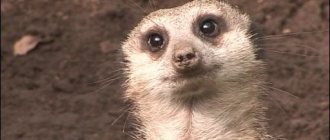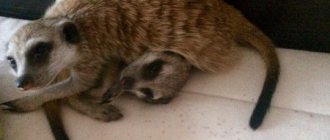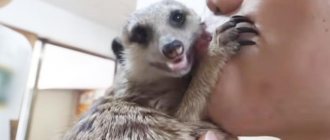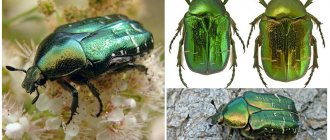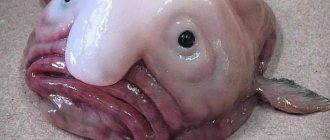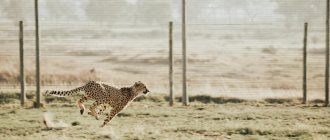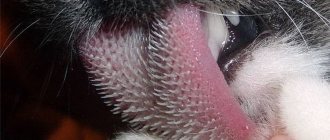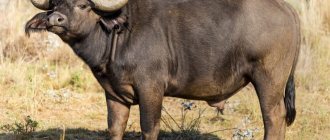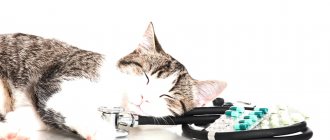- Wild animals
- >>
- Mammals
Some animal species are interesting not only in themselves, but also as social structures. Meerkats are like that. Their lives are most interesting to observe when they demonstrate their natural habits in full glory among their own kind. Despite the fact that meerkats evoke sympathy at first glance and touch people, in reality they are very cruel towards their relatives and are even considered one of the most bloodthirsty animals.
It is surprising that at the same time, meerkats are accustomed to teamwork, that is, despite the fact that they are capable of killing their comrade, they really need him. Meerkats have quite a warm relationship with people; they have long lived in houses, like cats, catching rodents and insects.
Origin of the species and description
Photo: Meerkat
Meerkats as a species belong to the mongoose family, order carnivores, suborder feliformes. Meerkats are not particularly similar to cats; their body shape is very different, and their habits and lifestyle are completely different. Although many evolutionists argue that the first felids appeared in the mid-Eocene period approximately 42 million years ago, the “common ancestor” of this entire group has not yet been discovered in paleontology. But an extinct species of meerkat was discovered, which led to the idea that these animals evolved from the striped mongoose, which lives in southern Africa.
Video: Meerkats
The name "meerkat" comes from the system name of the species Suricata suricatta. Sometimes in the literature there is a second name for the animal: thin-tailed myrkat. In fiction and television programs, meerkats are often called “sunny angels.” They received this name due to the fact that when they stand vertically under sunlight, the animal’s fur shimmers beautifully and looks as if the animal itself is glowing.
The meerkat's physique is slender. The animal's body is proportional. It has tall legs with four-toed feet and a long, thin tail. Meerkats have strong claws on their front paws, which serve them for digging holes and for getting insects from the ground. The animal’s body is also covered with thick fur.
Appearance and features
Photo: Animal meerkat
The meerkat is a small animal, only 700-1000 grams in weight. Slightly smaller than a cat. The body is elongated, about 30-35 centimeters including the head. Another approximately 20-25 centimeters is occupied by the animal’s tail. Theirs is thin, like a rat’s, and goes towards the tip. Meerkats use their tails as balance beams. For example, when animals stand on their hind legs, or when they repel snake attacks. When fighting a snake, the animal can use its tail as bait and a decoy.
It is very easy to measure the body length of a meerkat while he is observing something, standing on his hind legs. Meerkats take this position very often. Almost every time they want to look into the distance. They use their full height to ensure their viewing angle gives them as far a view as possible. This is how nature has adapted these animals to see predators even far from their own location.
Females have six nipples on their bellies. She can feed her cubs in any position, even standing on her hind legs. Females are larger than males and are considered to be in charge. The legs of meerkats are quite short, thin, sinewy and very powerful. Fingers are long with claws. With their help, meerkats are able to quickly dig the ground, dig holes, and move quickly.
The muzzle is small, relatively wide at the ears and very narrow towards the nose. The ears are located on the sides, rather low, small and round in shape. The nose is like a cat's or dog's, black. Meerkats have 36 teeth in their mouths, including 3 incisors on the right and left, above and below, one canine, 3 premolar incisors and two true molars. With them the animal is able to cut through the dense cover of tough insects and meat.
The entire body of the animal is covered with fur, on the side of the back it is thicker and darker, on the side of the belly it is less frequent, shorter and lighter. The color varies from light red and even yellow shades to dark brown tones. All meerkats have black stripes on their fur. They are formed by black-colored tips of hairs located next to each other. The muzzle and abdomen of the animal are most often light, and the ears are black. The tip of the tail is also painted black. Fur adds volume to a skinny animal. Without it, meerkats would look very thin and small.
Interesting fact: The meerkat does not have coarse fur on its belly. There the animal has only soft undercoat.
Threats
There are currently no serious threats to meerkat populations. The biggest threat to them is predators. The meerkat, which lives in the barren and arid regions of southern Africa and weighs less than a kilogram, is a tempting treat for birds of prey, including hawks and eagles.
When animals feed in broad daylight in the open air and away from their dens, they are vulnerable to attacks, especially by jackals. They are also preyed upon by a wide variety of terrestrial predators and reptiles, from snakes and crocodiles to lions and cheetahs. But meerkats are exceptionally resistant to the venom of the world's deadliest creatures: cobras. Only with repeated bites can they develop paralysis, coma or death.
Photo: ANDREW GRAHAM-BROWN
Where does the meerkat live?
Photo: Live meerkat
Meerkats are found exclusively in southern Africa.
They can be found in countries such as:
- SOUTH AFRICA;
- Zimbabwe;
- Namibia;
- Botswana;
- Zambia;
- Angola;
- Congo.
These animals are adapted to dry, hot climates and can withstand dust storms. That's why they live in deserts and semi-deserts. For example, meerkats are found in large numbers in the Namib Desert and Kalahari Desert areas.
Although they can be called hardy, meerkats are completely unprepared for cold snaps, and they have difficulty withstanding low temperatures. Those who like to have an exotic animal at home should remember this. In Russia, it is worth carefully monitoring home temperature conditions and eliminating drafts for the health of the animal.
Meerkats love dry, more or less loose soils so that they can dig a shelter in them. Usually it has several entrances and exits and allows the animal to hide from enemies through one entrance, and while the predator tears this place apart, the meerkat escapes through another exit. Animals can also use other people's burrows, dug by other animals and abandoned. Or simply hide in natural soil depressions.
If the terrain is dominated by rocky foundations, mountains, and outcrops, then meerkats happily use caves and nooks for the same purpose as burrows.
Habitat
Meerkats can be considered African endemic because they are found in the wild only on this continent. Most populations live near the Kalahari Desert and in South Africa, Botswana, western Angola and Namibia.
Meerkats prefer to settle in open desert and semi-desert areas devoid of vegetation. Representatives of the species can be found in the savannah and open plains. It is noteworthy that meerkats very often choose areas with fairly hard ground.
What does a meerkat eat?
Photo: Meerkat
Meerkats eat mostly insects. That's what they're called - insectivores. Usually they do not go far from their shelter, but dig nearby in the ground, in the roots, turn over stones and thereby look for food for themselves. But they do not have exclusive preferences in nutrition, so they have quite a variety of it.
Meerkats get nutrients from:
- insects;
- spiders;
- centipedes;
- scorpions;
- snake;
- lizards;
- eggs of turtles and small birds;
- vegetation.
One of the animals’ favorite pastimes is hunting scorpions, which live in large numbers in desert areas. Surprisingly, the venom of snakes and scorpions is practically not dangerous for the animal, since the meerkat is immune to these poisons. Although there are cases of increased reaction and very rare cases of death of animals stung by a snake or scorpion. Meerkats are very dexterous. They quickly get rid of the dal from the scorpions so they can safely eat it later.
They teach these techniques to their offspring, and while the cubs are not able to hunt themselves, meerkats fully provide them with food and teach them how to get their own food and hunt. They can also hunt and eat small rodents. Thanks to this feature, meerkats have gained popularity as pets.
Nutrition
Although meerkats are carnivores, they are, by and large, omnivores.
Fluffies feed on everything that could not escape from them - any insects and reptiles.
But if it was not possible to catch anything, the animal calmly switches to bird eggs, succulent vegetation and roots, when such are available in its place of residence.
If you keep an animal at home, you need to adhere to some rules in the meerkat diet.
Their daily homemade diet should look something like this:
- boiled chicken eggs sprinkled with calcium gluconate powder - one;
- raw chicken breast - a quarter;
- frozen or fresh zofobas, mealworms or marbled cockroaches - 10 pieces.
Raw eggs - chicken or quail - can weaken you. There must be fresh water or juice. The menu may also include minced meat, cucumbers and fruits.
A meerkat can also live at home. Take care of his housing and proper nutrition
Features of character and lifestyle
Photo: Meerkat animal
Meerkats are considered great intellectuals. To communicate with each other, they can use more than twenty words, each of which has several syllables. Interestingly, to warn of danger, their language has words that indicate the distance to the predator in terms of “far” and “near”. They also inform each other where the danger is coming from - by land or by air.
An interesting fact: first the animal signals to its relatives how far away the danger is, and only then – from where it is approaching. In addition, scientists have found that the cubs also learn the meaning of these words in this order.
The language of meerkats also has words indicating that exit from the shelter is free, or, conversely, that it is impossible to leave because there is danger. Meerkats sleep at night. Their way of life is exclusively daytime. In the morning, immediately after waking up, part of the flock stands guard, while other individuals go hunting. The changing of the guard usually occurs after a few hours. In hot weather, animals are forced to dig holes.
Interestingly, at the moment of digging, their ears seem to close so that earth and sand do not get into them.
Due to the fact that desert nights are cold and meerkats' fur often does not provide good thermal insulation, the animals freeze, so in a flock they often sleep tightly huddled together. This helps them stay warm. In the morning the whole flock warms up in the sun. Also, after sunrise, animals usually clean their homes, throw out excess soil, and expand their burrows.
In the wild, meerkats rarely live longer than six or seven years. Typically, the average life expectancy is four to five years. Meerkats also have many natural enemies; they often die, but the death of individuals is offset by high fertility, so the meerkat population does not decrease. And so, the mortality rate of animals is high, it reaches 80% in cubs and 30% in adults. In captivity they can live up to twelve years.
Social structure and reproduction
Photo: Meerkat gopher
Meerkats are very social animals. They do everything in groups. They live in large, numerous flocks, about 40-50 individuals. One group of meerkats can occupy an area of about two square kilometers, live and hunt on it. There are frequent cases of meerkats migrating. They have to roam in search of new food.
At the head of the pack are a male and a female, and the females are dominant; meerkats have a matriarchy. It is the female who is at the head of the flock who has the right to reproduce. If another individual reproduces, it can be expelled and even torn to pieces. The cubs that are born can also be killed.
Meerkats are prolific. Females are able to bear new offspring three times a year. Pregnancy lasts only 70 days, and lactation lasts about another seven weeks. One litter can have from two to five cubs. The entire flock usually takes care of the offspring of a dominant pair. Members of the clan bring food, bite parasites out of the puppies' fur until they are able to do it themselves, and protect them in every possible way. It comes to the point that if a flock is attacked by a large enough predator, and everyone does not have time to hide from it, then the adults cover the cubs with themselves, and thereby save the young at the cost of their own lives.
The education of young in packs is very good, which greatly distinguishes meerkats from other animals, whose offspring learn not in the process of education, but in the process of observing the behavior of their parents. It is believed that the reason for this feature is the harsh desert conditions of their habitat.
Interesting fact: Tamed meerkats, unlike wild ones, are very bad parents. They are capable of abandoning their young. The reason is that animals pass on their knowledge to the new generation through training, and in meerkats it plays a greater role than instincts.
Keeping at home
Meerkats are highly tamed. In their natural habitat, they are often kept as exterminators of rodents, spiders, insects and snakes. The animals, accustomed to warmth, are very sensitive to low temperatures, but if proper conditions are provided, they can be kept in places with cold climates, including Russia.
Meerkats kept as pets are not inferior to cats and dogs that are more familiar to us in their sociability, playfulness and cheerfulness. In addition, the animals do not damage furniture, do not chew wires, do not make a lot of noise and are friendly towards all inhabitants of the house.
However, keeping such an exotic pet has some features:
- since in natural conditions animals live in families, it is better to purchase two animals so that they can communicate with each other and take care of each other;
- meerkats should not be kept in cages, but in a free settlement; for rest they will need a house with bedding;
- animals learn to go to the litter box, but training will take some time;
- In summer, animals can be walked on a leash; with the onset of cold weather, walks should be canceled;
- Meerkats do not like to bathe or swim, so water procedures should not be carried out too often.
Owners will also have to take care of timely vaccination of their pets against distemper and rabies. Meerkats are vaccinated in the same way as ferrets.
Before purchasing an animal from a nursery, you should inquire about the living conditions of the animals. As a rule, home-bred cubs are already litter box trained and are more tame and affectionate. If animals are kept in enclosures, caring for them at first will be associated with certain difficulties.
MUSKRAT
Natural enemies of meerkats
Photo: Meerkat cubs
The small size of the animals makes them potential victims of many predators. On land, meerkats are hunted by jackals. They are threatened from the sky by eagle owls and other birds of prey, especially eagles, which hunt not only small cubs, but even adult meerkats. Sometimes quite large snakes can crawl into their holes. For example, the king cobra is capable of feasting not only on still-blind puppies, but also on relatively large, almost adult individuals—those it can handle.
In addition, meerkats have to fight not only with predators, but also with their relatives. In fact, they are their own natural enemies. It is believed that flocks of meerkats very quickly eat up the food available in the area and devastate their areas of residence. And because of this, the clans are forced to constantly wander from one place to another.
This leads to inter-clan wars for territory and food supplies. The battles between the animals are very brutal; every fifth of the fighting meerkats dies in them. At the same time, females defend their burrows especially fiercely, since when the clan dies, enemies usually kill all the cubs without exception.
Meerkats only fight with members of their own species. They try to hide from predators in a shelter or flee. When a predator appears in its field of vision, the animal informs its relatives by voice so that the entire flock is aware and can take cover.
Raising offspring
This issue is a separate topic that meerkats take very seriously.
Photos of funny and amusing cubs in which they behave carefree reflect only a small part of their life.
An important aspect for a child is to acquire the skill of correct behavior while hunting.
After all, meerkats feed on far from the safest types of insects and reptiles. Here, raising young animals is divided into three main stages:
- First, they are brought thoroughly tortured, half-dead or dead “food” and ensure that it is safely eaten.
- Next, the prey is delivered to the babies more and more “alive”, less traumatized.
- Now the young meerkat is ready to go hunting; at first he must stick with his more experienced relative.
Interesting! The entire clan takes part in the socialization and education of young meerkats. Not only their mother, but also other females take care of the newborn babies.
What love!
